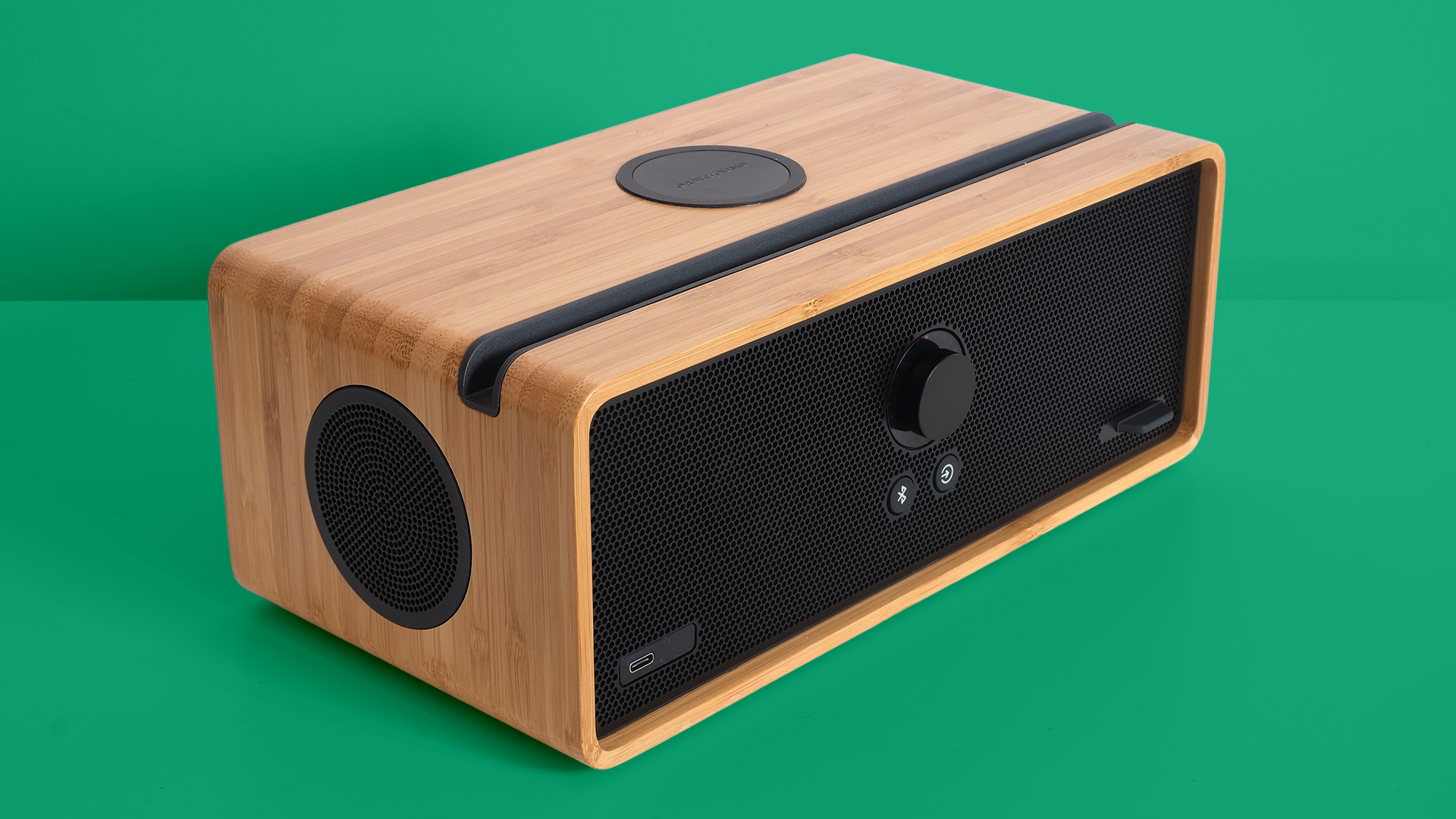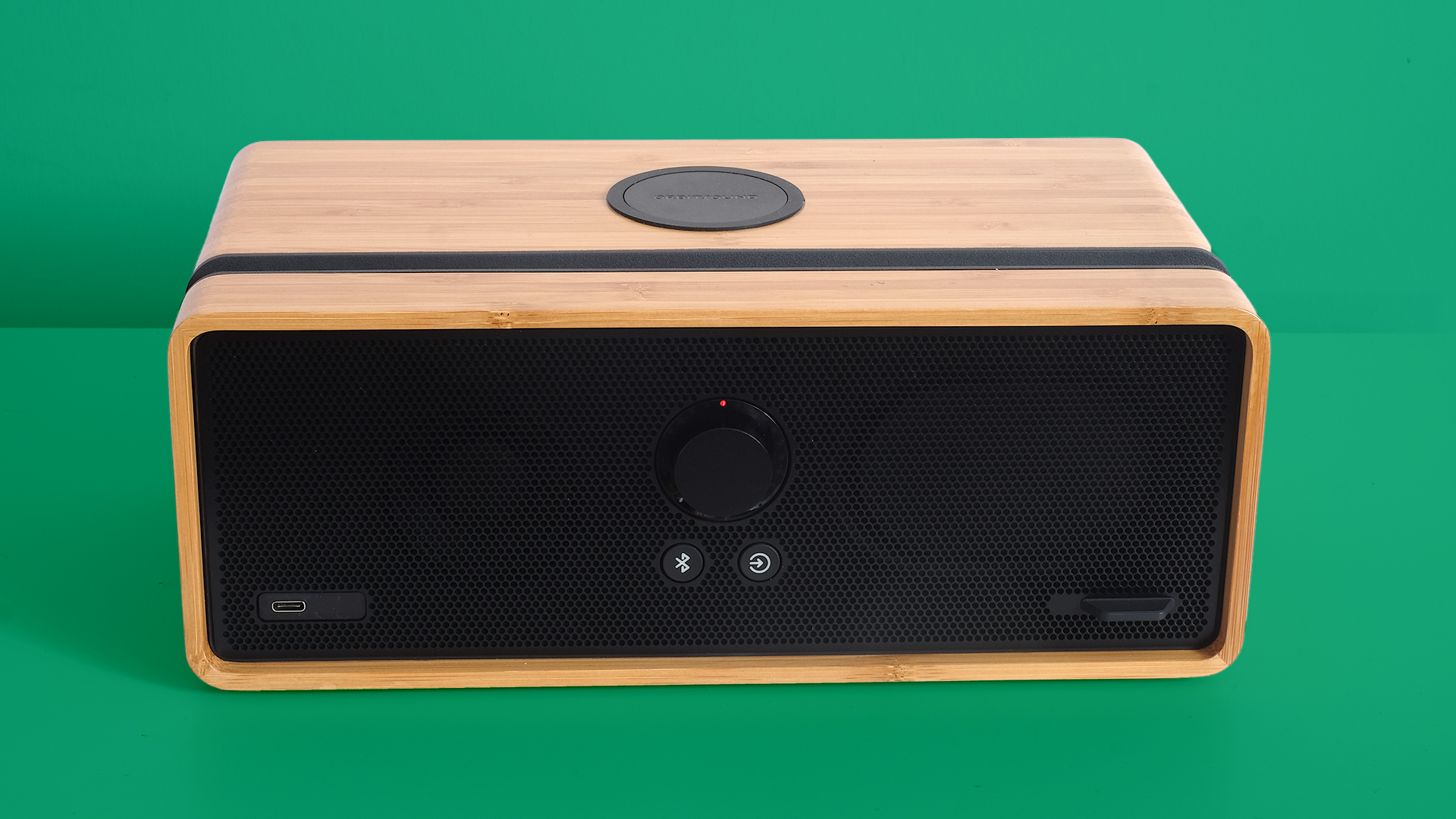TechRadar Verdict
The Orbitsound E30 is more living room-friendly than most wireless speakers, although it’s not quite the best-sounding in its class. Despite some performance issues, it looks great, isn’t too big, it’ll hold up your tablet and charge your phone.
Pros
- +
Wide sound dispersal
- +
Lots of lifestyle features
- +
Good looks
Cons
- -
Airsound feature has issues
- -
Not quite the best-sounding
Why you can trust TechRadar
The Orbitsound Dock E30 is a wireless speaker that adds a few extra squirts of lifestyle juice to your pragmatic lemonade. It has a slot for your phone or tablet or, if you've got a phone that uses Qi charging, you can just place your phone on its top.
Despite its good looks and better features (like its sound-expanding Airsound tech), the Orbitsound Dock E30 doesn’t sound quite as good as the best wireless speakers - especially when stacked against the likes of the Sonos Play:5 or Harman Kardon Go+Play, both of which sound better to our ears.
If you can look past its limitations in the performance department, however, the E30 is good enough to act as your main hifi hub and will look great in your living room.

Design
The Orbitsound Dock E30 is smaller than most premium wireless speakers. It’s around half the height of a Sonos Play:5 at 114mm tall, and benefits from a design that, thankfully, is not just a block of plastic.
Our review sample, for example, had a bamboo finish, which looks like a miniature version of someone’s fancy wood flooring. The Orbitsound Dock E30 also comes in black and white, if the wood effect doesn’t appeal.
Speaking of style, the black speaker grilles on its sides reduce its style cred a little but they are hardly apparent at all in the all-black version.
It weighs a solid 4kg, but weight doesn’t really matter here as the Orbitsound Dock E30 needs to be plugged in to work. There’s no battery and it’s not portable, however, so keep that in mind when you're making your decision.
Sign up for breaking news, reviews, opinion, top tech deals, and more.

In some better news, the Orbitsound Dock E30’s low profile makes it look great in the average home. It doesn’t claim too much space, or seem like a tower of tech - a problem we've seen before with other Bluetooth speakers.
Like to see a speaker’s drivers hard at work? The metal front grille is kept in place with a magnet, and there’s a little grip on the bottom right that lets you pull this front plate off ... just don't let your pets or little ones near the drivers.
There are a few simple controls on the Orbitsound Dock E30’s front, too. The button with an arrow switches between sources, and a Bluetooth button lets you pair up with phones and tablets easily. Above these sits a volume control knob. A circle of LEDs around it lets you know the volume level as it is turned.
Features
It may be made with living spaces in mind, but the Orbitsound Dock E30 is still packed with tech-friendly features. There’s a Qi charger pad on its top that lets you wirelessly charge your phone if it supports the Qi standard, like recent Samsung Galaxy flagships, the Samsung Galaxy S8 and the Samsung Galaxy S8+, or Apple's iPhone 8, iPhone 8+ and iPhone X.
Alternatively, if your phone isn't up-to-date on the latest tech, you can plug your phone directly into the USB-C port on the front. However, you may need to buy a new cable as most phone leads end with a full-size USB plug, not a USB-C.
The Orbitsound Dock E30 mixes new features with traditional ones. An IR remote is included letting you alter volume, bass and treble, mute the speaker or change tracks. There’s even a “learning” mode that lets you use other remotes to alter volume. This is extra-handy if you want to plug the E30 into your TV.

The speaker also has a slot in its top, letting you rest your phone or tablet up there. It’s a nod to the days when we used to plug our phones into docks with actual physical connectors, although the real appeal is for tablet owners: Phones fit in your pocket, tablets don’t.
There are also wired connections on the back (Aux and optical inputs make plugging the Orbitsound Dock E30 into your TV easy) but its pièce de résistance is its spectacular wireless support.
There’s Bluetooth, to stream any audio you like from your phone, and Wi-Fi. There are several strands to the Wi-Fi, too. You can use Spotify Connect, AirPlay (AirPlay 2 is coming later in 2018), and the Orbitsound app supports several other streaming services.
There’s TIDAL, Napster, Spotify (again), iHeartRadio and TuneIn. Dig deeper into the app and you can add several Chinese services you’ve probably never heard of, like QQ Music and Ximlaya. This is a sign that while the app appears to be made by Orbitsound, it’s likely a tweaked version of an existing platform.
Overall, we thought the app wasn’t as glossy as Sonos’s, but it worked well enough. It also lets you control Orbitsound speakers multi-room style, although this strikes us as the sort of speaker many will use as a standalone system.

Performance
The Orbitsound Dock E30 initially looks as if it has masses of drivers. But there’s actually just one active driver on its front, 48mm in diameter.
This is joined by three very large passive radiators, which act a little like subwoofers. There’s an additional 48mm driver on each side, but these are only used for the Orbitsound Dock E30’s Airsound feature.
Airsound, by the way, is an Orbitsound exclusive. It pipes out certain parts of the mix through these side speakers to dramatically increase the width of the sound. This significantly reduces how positional music seems, helping it fill rooms rather than just blasting out sound in one direction.
There are issues, though. While Airsound is effective, it can sometimes have quite a negative impact on the audio. For example, playing Kate Bush’s Hounds of Love, the Orbitsound Dock E30 identifies the lead vocal as an “ambient” part of the mix to be played by the side drivers. It all-but removes the vocal, ruining the track.
It is also a negative influence when playing Room 29, the collaboration between Jarvis Cocker and Chilly Gonzales. The track is a combo of resonant, natural-sounding piano and a deep vocal. And the Airsound makes the piano sound as if it is being played through a low-quality transistor radio. It sounds almost toy-like, and is quite hard on the ear at high volumes.

Hold down the two buttons on the front then twist the volume knob and you can increase or lower the Airsound effect. But remove it altogether and the Orbitsound Dock E30 only uses one of its three active drivers. Seems like a waste, right?
You will probably want to turn Airsound off if you’re sat close to one of the side drivers as it’s a little like sitting right next to one of the rear speakers in a surround system.
When Airsound isn’t playing up, the Orbitsound Dock E30’s sound quality is very good. It’s relatively well-balanced, the mids are healthy and AirSound really helps the speaker fill rooms.
You can hear the triple passive radiators working their magic, too. Bass is fairly deep and assured for a speaker of this size and mid-range detail is good, giving vocals a sense of solidity. These mids do rely a little on a bed of mid-bass, but this is only apparently when comparing directly with its best-in-class rivals.

The Orbitsound Dock E30 doesn’t quite match these best performers, though, such as the Sonos Play:5 and Harman Kardon Go + Play. That Harman Kardon unit is a simpler but cheaper Bluetooth speaker. Both have deeper bass, more coherent mids, better dynamics and greater soundstage separation.
While Airsound gets rid of that sense the audio is coming from a single point, it doesn’t guarantee soundstage detail and definition. Here such properties are good, but not the best around.
Verdict
The Orbitsound Dock E30 is a great fit for the average lounge: It looks great, isn’t too big, it’ll hold up your tablet and charge your phone.
Despite its obvious style advantage, sound quality doesn’t quite match the very best sub-£500 wireless speakers. Sure, it sounds good enough to work as your main hifi, and the Airsound feature helps fill rooms with music, but there are better all-around performers out there that play nicely with all of your music, not just some of it.
